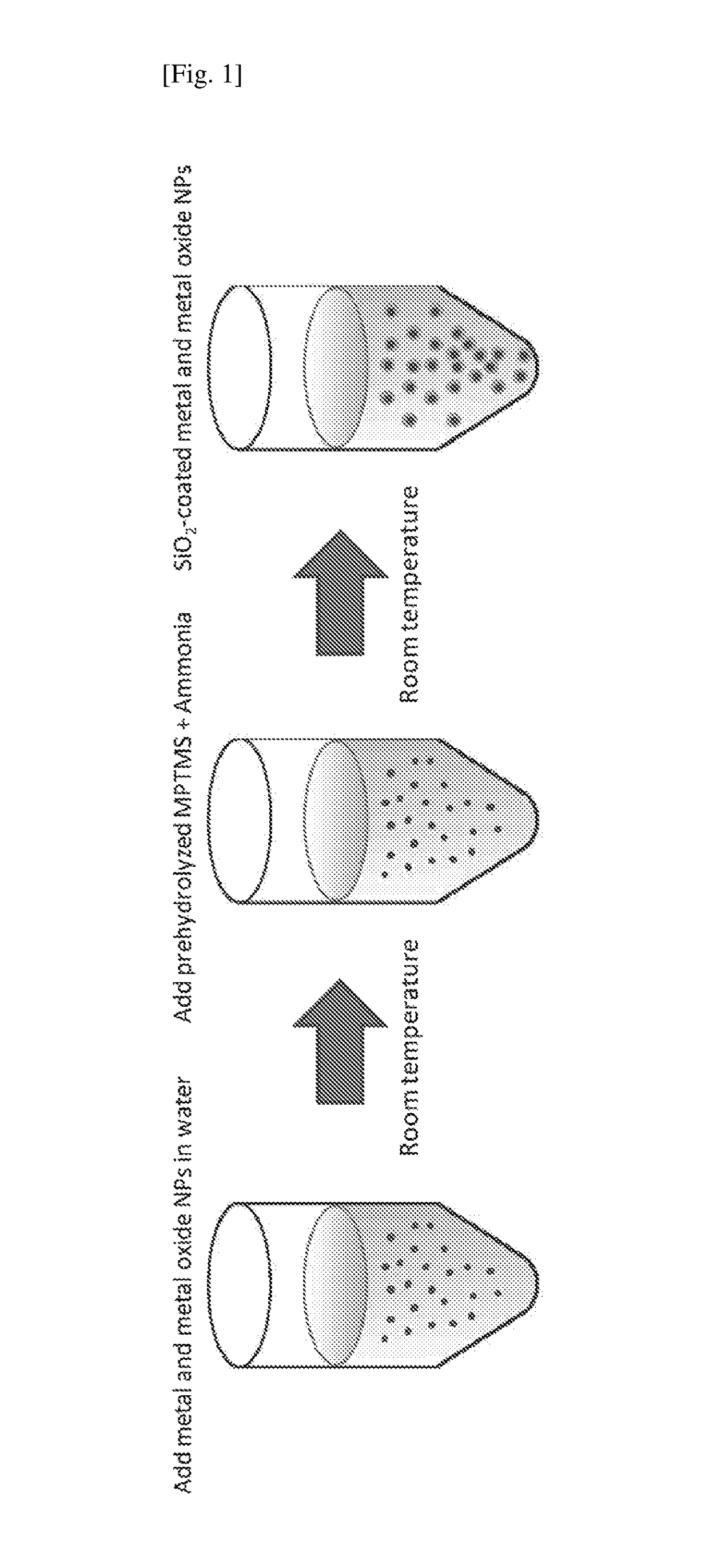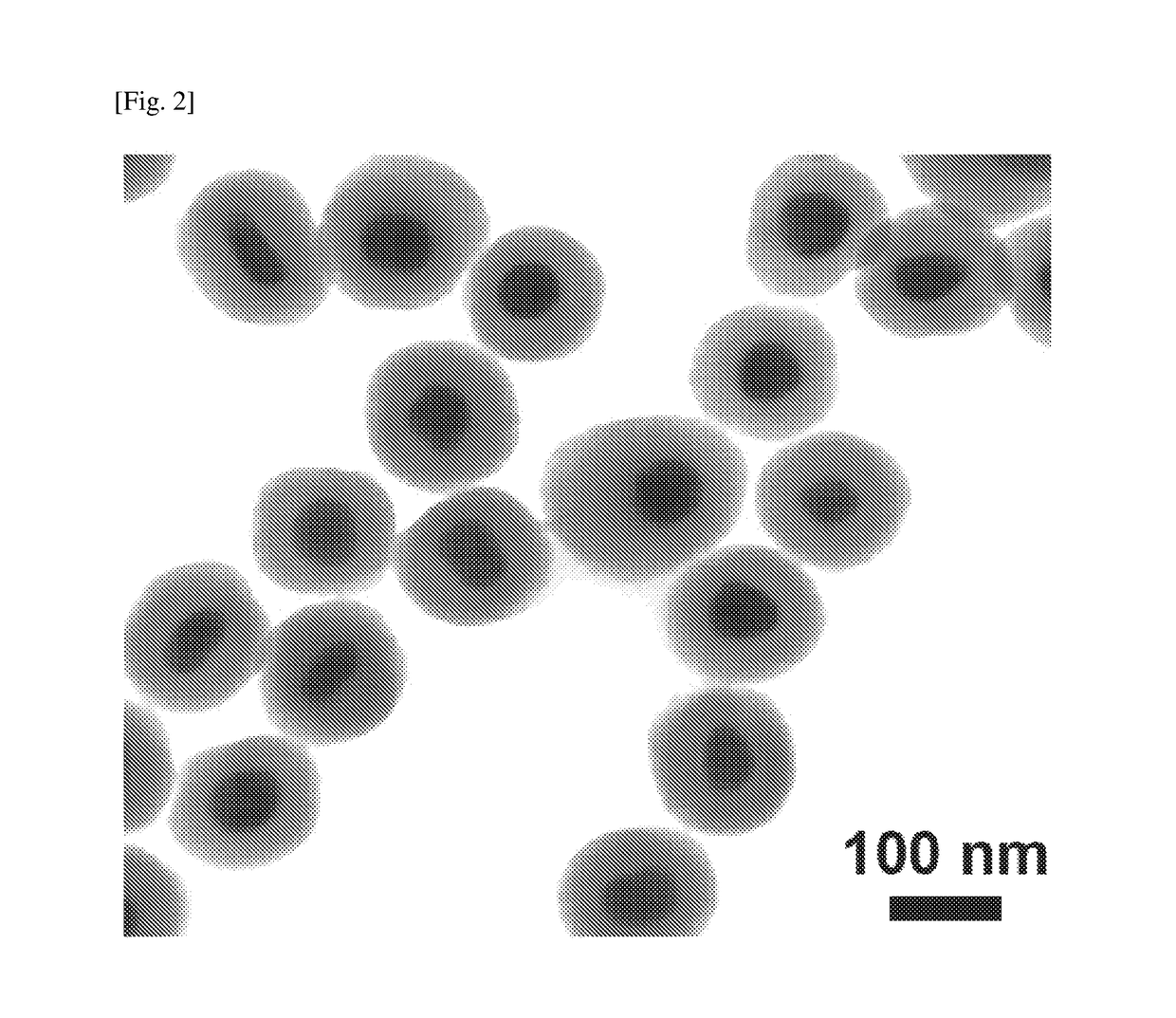Silica coating on nanoparticles
a technology of nanoparticles and nanoparticles, which is applied in the direction of silicon oxides, nanostructures, silicon oxides, etc., can solve the problems of less environmental protection, difficult large-scale production, and inability to soluble silane precursors in conventional methods, etc., to achieve more environmental protection, more cost-effective, and simple
- Summary
- Abstract
- Description
- Claims
- Application Information
AI Technical Summary
Benefits of technology
Problems solved by technology
Method used
Image
Examples
example 1
Synthetic Procedure
[0081]Silver nitrate (AgNO3, ≥99.5%), tetrachloroauric acid trihydrate (HAuCl4.3H2O, ≥99.9%), hexachloroplatinic acid hexahydrate (H2PtCl6.6H2O, ≥37.5%), 3-(mercaptopropyl)trimethoxysilane (MPTMS, 95%), and sodium citrate dihydrate (≥99%) were used as received from Sigma-Aldrich Ammonia solution (30 wt %) and absolute ethanol (99%) were also used as received from Mallinckrodt and Honeywell, respectively. Deionized water was used throughout all experiments.
[0082]Metal NPs and Metal Oxide Nanoparticles
[0083]Ag, Pt and Au NPs were selected to represent metal NPs and ZnO and TiO2 NPs were selected to represent metal oxide NPs.
[0084]Preparation of 50 nm Ag NPs
[0085]Typically, an aqueous solution of sodium citrate (10 mL, 40 mM) was added dropwise into a boiling aqueous solution of silver nitrate (490 mL, 1 mM) in a period of 2 min under vigorous stirring. After boiling for 1 h, the reaction solution was allowed to cool to room temperature followed by centrifugation at ...
example 2
Characterization of the NPs
[0095]Transmission Electron Microscopy (TEM) Images
[0096]Transmission electron microscopy (TEM) images of the SiO2-coated Ag, Pt and Au NPs are shown in FIGS. 2, 3 and 4 respectively. FIG. 2 shows SiO2 coated Ag NPs having an Ag particle size of approximately 50 nm and a SiO2 layer thickness of approximately 30 to 40 nm. FIG. 3 shows SiO2 coated Pt NPs having a Pt particle sized of approximately 50 nm and a SiO2 layer thickness of approximately 10 to 15 nm. FIG. 4 shows SiO2-coated Au NPs having an Au particle size of approximately 50 nm and a SiO2 layer thickness of 50 to 70 nm.
[0097]TEM images of SiO2-coated ZnO and TiO2 NPs are shown in FIGS. 5 and 6 respectively. FIG. 5 shows SiO2-coated ZnO NPs having a particle size of approximately 100 to 150 nm and a SiO2 layer thickness of approximately 5 to 10 nm. FIG. 6 shows SiO2-coated TiO2 NPs having a TiO2 particle size of approximately 150 to 200 nm and a SiO2 layer thickness of approximately 10 to 15 nm.
[0...
example 3
[0103]Investigation of the Mechanism
[0104]The mechanism of SiO2 coating on the surface of NPs in aqueous solution using MPTMS as the SiO2 precursor is investigated by using 29Si nuclear magnetic resonance (NMR) spectroscopy. The 29Si NMR spectra of MPTMS monomer, hydrolyzed MPTMS monomer and SiO2 formed are compared in FIG. 10. The SiO2 coating mechanism is described in combination with the 29Si NMR results. Tin represents the number of connectivity (n) of silicon atoms to form a siloxane bond (Si—O—Si).
[0105]Hydrolysis
[0106]Initially, an oil-in-water emulsion is formed when MPTMS monomer (FIG. 10a) is added to water, and the solution appears turbid due to MPTMS droplets. After shaking for about 1 to 2 hours at room temperature, the droplets gradually disappear, this being accompanied with the disappearance of turbidity. This occurs due to the hydrolysis of the three methoxy (—OCH3) groups in the MPTMS molecule (HS(CH2)3Si(OCH3)3) to hydroxyl (—OH) groups, resulting in the formation...
PUM
| Property | Measurement | Unit |
|---|---|---|
| temperature | aaaaa | aaaaa |
| temperature | aaaaa | aaaaa |
| temperature | aaaaa | aaaaa |
Abstract
Description
Claims
Application Information
 Login to View More
Login to View More - R&D
- Intellectual Property
- Life Sciences
- Materials
- Tech Scout
- Unparalleled Data Quality
- Higher Quality Content
- 60% Fewer Hallucinations
Browse by: Latest US Patents, China's latest patents, Technical Efficacy Thesaurus, Application Domain, Technology Topic, Popular Technical Reports.
© 2025 PatSnap. All rights reserved.Legal|Privacy policy|Modern Slavery Act Transparency Statement|Sitemap|About US| Contact US: help@patsnap.com



